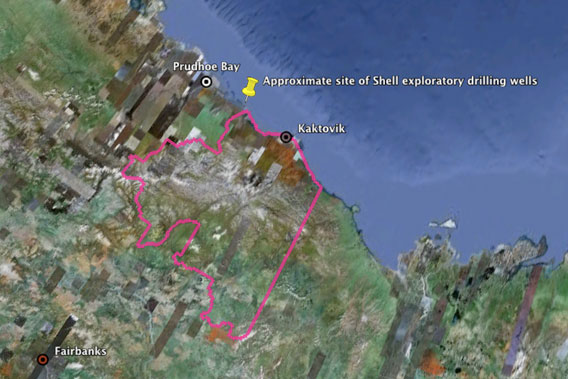
Approximate site of preliminarily approved drilling by Shell in the Chukchi Sea. Pink outline is the Arctic National Wildlife Refuge (ANWR). Image made with Google Earth.
In the same week that sea ice in the Arctic Ocean hit another record low due to climate change, the Obama Administration has given final approval to Royal Dutch Shell to prepare for exploratory drilling in the region. Vehemently opposed by environmentalists and indigenous groups, the drilling plans are a part of the Obama Administrations ‘all of the above’ energy policy. Whether or not Shell will actually drill a well this season, however, is still up in the air as its oil spill containment barge remains docked in Washington state for an upgrade that could last several days.
“Shell will not be authorized to drill into areas that may contain oil unless the spill containment system is fully certified, inspected and located in the Arctic,” clarified James Watson, head of the Department of the Interior’s Bureau of Safety and Environmental Enforcement. Even before the oil spill barge arrives, however, Shell will be able to drill 1,500 feet into the Arctic Ocean surface and install a blowout preventer.
Initially Shell had hoped to drill five oil wells this summer, but given that time is running out it has scaled that down to two. Shell, which has several ships headed to the Arctic currently, must abide by a government-set deadline to finish operations ahead of the Arctic winter when the sea re-freezes.
Investing $4.5 billion into the endeavor, Shell has staked a significant chunk of time, energy, and funds on Arctic Ocean drilling. Still, given the perilous and remote conditions, critics say there is no way to deal with an oil spill in region. Once winter sets in, including sea ice and ever-present darkness, it is likely any attempt to mitigate an oil spill would have to be abandoned.
“The technology simply doesn’t exist to effectively contain a spill in the extreme environment of the Arctic Ocean. This is one of the most productive marine areas in the world, supporting hundreds of species and thousands of people who depend on the sea’s bounty. To drill in our Arctic Ocean is to gamble with its future,” Margaret Williams, Managing Director for World Wildlife Fund’s (WWF) Arctic Program, said in a statement.
Cindy Shogan, Executive Director with the Alaska Wilderness League called the decision “at best irresponsible.”
“Over the past few months, Shell has consistently broken its promises in the Arctic – from losing control of [its oil rig the Discoverer] in waters hundreds of miles to the south of the Arctic to revealing that it cannot meet previously-agreed to Clean Air Act regulations,” she adds.
But Ken Salazar, Interior Secretary with the Obama Administration, who approved the permits, anticipates no problems.
“We’re confident that it can be done safely and without risk to the environment,” Salazar said during a call about the approval, though he noted there was no guarantee Shell would actually begin drilling this year.
For its part Shell says that it has the capacity to encounter 95 percent of any oil spill, but doesn’t note how much of that it could actually remove from the environment.
Drilling for fossil fuels in the Arctic has become a global struggle between energy companies and environmentalists with energy companies largely winning to date. Recently Greenpeace has been taking non-violent action in the Russian Arctic, attempting to stop drilling activities by oil giant Gazprom, including occupying an oil rig.
Related articles